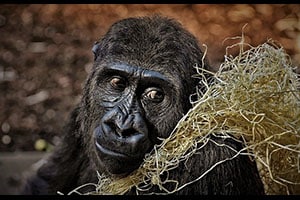 According to the dictionary of the Royal Spanish Academy ( RAE ), the etymological root of gorilla is found in the Greek word Górillai , which translates as "tribe of hairy women." This term derived from the scientific Latin gorilla , which later came to our language as gorilla.
According to the dictionary of the Royal Spanish Academy ( RAE ), the etymological root of gorilla is found in the Greek word Górillai , which translates as "tribe of hairy women." This term derived from the scientific Latin gorilla , which later came to our language as gorilla.
A gorilla is a mammalian animal that is part of the group of primates . It lives on the African continent, can measure up to two meters tall and is characterized by its arms being much longer than its legs.
Gorillas usually move on all fours. Their diet is mainly herbivorous as they eat shoots, leaves and fruits, although they can also ingest insects.
These animals are born after a gestation of eight and a half months. The young usually remain with their mothers until they are 3 or 4 years old, reaching sexual maturity between 10 and 12 years in the case of females or between 11 and 13 in the case of males. It is important to mention that a gorilla can live up to 50 years.
About 98% of gorilla DNA is identical to that of humans. These animals usually use tools , such as rocks to split coconuts or logs as a bridge. That is why scientists highlight their great intelligence. Unfortunately, due to habitat destruction and poaching, gorillas are endangered animals.
Below we will see some of the many curiosities that revolve around these animals. First of all, it is important to note that they are not considered within the group of monkeys . Both species are primates, so they are related, but their physical characteristics allow us to distinguish them with the naked eye: for example, monkeys have tails, unlike gorillas and other large apes.
Since the gorilla is such a powerful looking animal, many people assume that it eats meat , that it is a great hunter. But the reality is very different, since it is a mainly herbivorous species , as mentioned above, which on certain occasions includes small invertebrate animals in its diet.
 Gorillas are divided into two species: the western and the eastern. In turn, each of them is subdivided into two others: both have their subspecies of plain or plain; The western one also includes the Cross River, while the eastern one is the mountain one.
Gorillas are divided into two species: the western and the eastern. In turn, each of them is subdivided into two others: both have their subspecies of plain or plain; The western one also includes the Cross River, while the eastern one is the mountain one.
Returning to its habits, mentioned above regarding feeding, the gorilla is not an aggressive animal. On the contrary, and despite what its imposing image may lead us to think, it is not only peaceful but can show a timid attitude towards human beings. This idea that arises in us originates from its large size, since it is the largest primate.
The gorilla is related to humans, although in third place, after the common chimpanzee and the bonobo . Generally, groups of gorillas have as their leader a male who is called silverback , precisely because of a white spot that forms on their hair when they reach maturity , something that happens around twelve years of age.
Although they can stand and walk on two legs, they do not achieve this for long distances, but only for a few meters. They normally rest their knuckles on the ground to move with all four legs.
In some Latin American countries, on the other hand, the subject who accesses power by force is derogatorily described as a gorilla. In the specific case of Argentina , the reactionary and conservative individual who opposes popular movements and, especially, Peronism, is called a gorilla.
